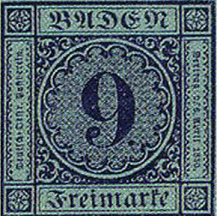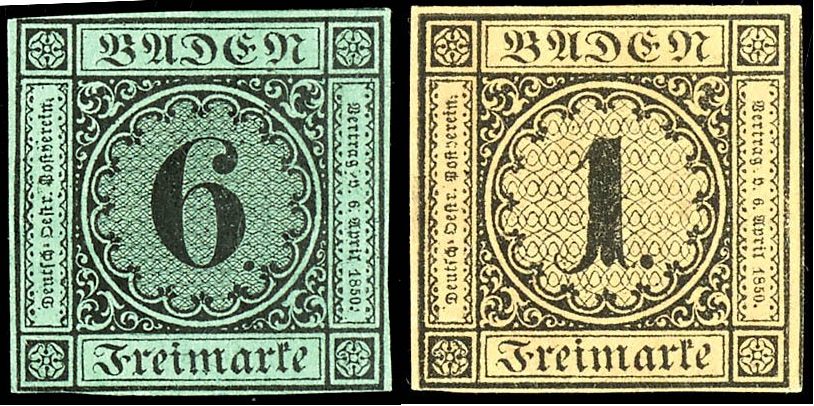The Grand Duchy of Baden, a German state in the 19th century, played a significant role in the postal history of Europe. The issuance of postage stamps in Baden was a crucial development in its communication system, aligning with the broader movement toward organized postal services in the German Confederation. This article explores the early Baden stamps, their historical significance, the rule of Grand Duke Leopold I, and the valuation of these stamps in today’s philatelic market.

The Grand Duchy of Baden and Grand Duke Leopold I
Baden was a sovereign state in southwestern Germany, bordering France and Switzerland. It became a Grand Duchy in 1806 following the Napoleonic Wars and remained a distinct entity until its integration into the German Empire in 1871.
Grand Duke Leopold I, who reigned from 1830 until his death in 1852, was instrumental in modernizing Baden. His reign saw advances in civil liberties, infrastructure, and administration, including postal reforms. The postal service in Baden was among the first in the German-speaking world to adopt postage stamps, a revolutionary step at the time.
The Postal System and the 1851 Stamp Issue
Baden joined the German Austrian Postal Union in 1850, necessitating a structured postal system. On May 1, 1851, the first series of postage stamps was issued. These stamps, characterized by their black impression on coloured paper, were imperforate and bore distinctive designs. They facilitated efficient communication across Baden and beyond, reflecting the duchy’s progressive stance in adopting modern postal systems.
The Stamps of 1851
The 1851 Baden stamp series consisted of multiple denominations, each with a unique colour scheme:
- 1 Kreuzer on Buff Paper
- Issued: May 1, 1851
- Market Price: £5,500 (unused), £1,300 (used)
- Description: A black-printed stamp on buff-coloured paper. One of the most valuable stamps from the Baden series due to its rarity in unused condition.
- 1 Kreuzer on Brown Paper (Issued September 15, 1851)
- Market Price: £800 (unused), £425 (used)
- Description: A variation of the 1 Kreuzer stamp, printed on brown paper. Less common but still sought after by collectors.
- 3 Kreuzer on Orange Paper
- Market Price: £2,500 (unused), £60-£100 (used)
- Description: An eye-catching orange background with a black-printed design. One of the most frequently collected Baden stamps.
- 3 Kreuzer on Yellow Paper (Issued August 19, 1852)
- Market Price: £400 (unused), £26-£60 (used)
- Description: Similar in design to the orange 3 Kreuzer but printed on a yellow background. Less valuable than the orange variant.
- 6 Kreuzer on Blue-Green Paper
- Market Price: £6,000 (unused), £140 (used)
- Description: A striking colour combination that makes this stamp highly collectible. Its high value in unused condition attests to its rarity.
- 6 Kreuzer on Yellow-Green Paper (Issued March 15, 1852)
- Market Price: £1,300 (unused), £80-£100 (used)
- Description: A minor variation of the blue-green 6 Kreuzer, issued later in 1852.
- 9 Kreuzer on Rose Paper
- Market Price: £7,000 (unused), £250 (used)
- Description: Among the most valuable Baden stamps, the rose-coloured 9 Kreuzer is rare and highly coveted in unused form.
- 9 Kreuzer on Dull Rose Paper (Issued October 21, 1851)
- Market Price: £325 (unused), £46-£60 (used)
- Description: A slight variation of the standard 9 Kreuzer, featuring a duller shade of rose.

- Error Stamp – 6 Kreuzer on Green Paper
- Market Price: Extremely rare
- Description: A printing error led to a green background instead of the intended blue-green. Only three known examples exist, making this one of the rarest stamps in philately.
Rarity and Market Value
The most valuable stamp from this series is the 6 Kreuzer on Green Error (No. 6ab). Only three examples are known to exist: one “on piece,” valued at £1,430,000, and two covers, one of which resides in the German Post Office Museum, valued at £2,427,000. Due to its rarity, this error stamp is considered one of the most important and valuable in the philatelic world.
Forgery Concerns
Due to the high value of Baden stamps, numerous forgeries exist. Collectors should be wary of stamps cancelled with fraudulent markings, such as “164,” “WERTHRIM,” or “ALTHAUSEN 28 SEP 56.” These are known forgeries and do not carry authentic value.
The Legacy of Baden Stamps
Despite Baden’s eventual integration into the German Empire in 1871, its postage stamps remain a crucial part of European philatelic history. They reflect not only the technological advancements of the time but also the growing need for efficient communication across emerging nation-states. Collectors and historians alike treasure these stamps, both for their aesthetic appeal and their role in the broader story of European postal evolution.
Conclusion
The 1851 Baden postage stamps are more than just collectibles; they are artifacts of an era marked by innovation, unification, and modernization. From Grand Duke Leopold I’s reign to the pioneering German-Austrian Postal Union, these stamps symbolize the transformation of European communication. Whether you are a seasoned collector or a history enthusiast, the story behind Baden’s stamps is one worth exploring.
For those looking to invest in these stamps, understanding their historical context, rarity, and market value is essential. While some remain relatively accessible, others, like the famous 6 Kreuzer on Green Error, remain among the most sought-after and valuable stamps in the world. Their legacy endures, continuing to fascinate and inspire the world of philately.


